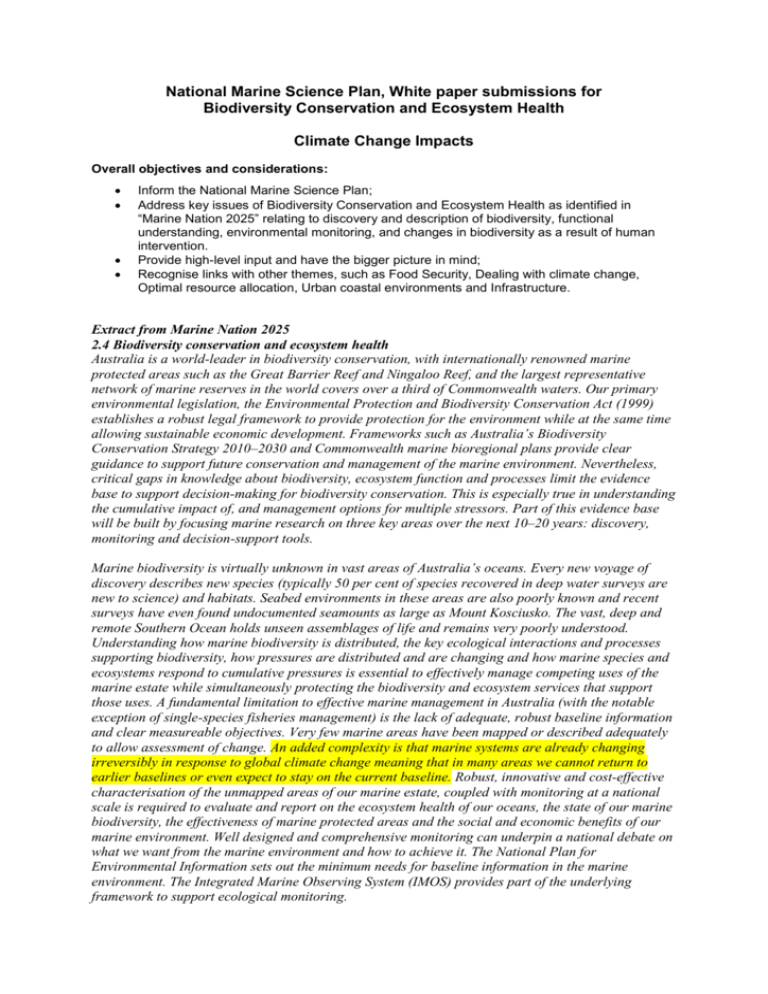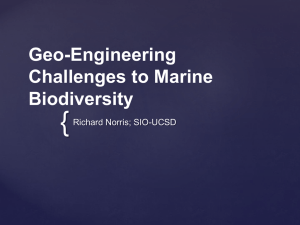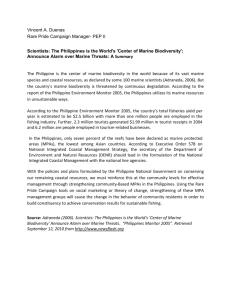White paper template - Centre for Marine Science
advertisement

National Marine Science Plan, White paper submissions for Biodiversity Conservation and Ecosystem Health Climate Change Impacts Overall objectives and considerations: Inform the National Marine Science Plan; Address key issues of Biodiversity Conservation and Ecosystem Health as identified in “Marine Nation 2025” relating to discovery and description of biodiversity, functional understanding, environmental monitoring, and changes in biodiversity as a result of human intervention. Provide high-level input and have the bigger picture in mind; Recognise links with other themes, such as Food Security, Dealing with climate change, Optimal resource allocation, Urban coastal environments and Infrastructure. Extract from Marine Nation 2025 2.4 Biodiversity conservation and ecosystem health Australia is a world-leader in biodiversity conservation, with internationally renowned marine protected areas such as the Great Barrier Reef and Ningaloo Reef, and the largest representative network of marine reserves in the world covers over a third of Commonwealth waters. Our primary environmental legislation, the Environmental Protection and Biodiversity Conservation Act (1999) establishes a robust legal framework to provide protection for the environment while at the same time allowing sustainable economic development. Frameworks such as Australia’s Biodiversity Conservation Strategy 2010–2030 and Commonwealth marine bioregional plans provide clear guidance to support future conservation and management of the marine environment. Nevertheless, critical gaps in knowledge about biodiversity, ecosystem function and processes limit the evidence base to support decision-making for biodiversity conservation. This is especially true in understanding the cumulative impact of, and management options for multiple stressors. Part of this evidence base will be built by focusing marine research on three key areas over the next 10–20 years: discovery, monitoring and decision-support tools. Marine biodiversity is virtually unknown in vast areas of Australia’s oceans. Every new voyage of discovery describes new species (typically 50 per cent of species recovered in deep water surveys are new to science) and habitats. Seabed environments in these areas are also poorly known and recent surveys have even found undocumented seamounts as large as Mount Kosciusko. The vast, deep and remote Southern Ocean holds unseen assemblages of life and remains very poorly understood. Understanding how marine biodiversity is distributed, the key ecological interactions and processes supporting biodiversity, how pressures are distributed and are changing and how marine species and ecosystems respond to cumulative pressures is essential to effectively manage competing uses of the marine estate while simultaneously protecting the biodiversity and ecosystem services that support those uses. A fundamental limitation to effective marine management in Australia (with the notable exception of single-species fisheries management) is the lack of adequate, robust baseline information and clear measureable objectives. Very few marine areas have been mapped or described adequately to allow assessment of change. An added complexity is that marine systems are already changing irreversibly in response to global climate change meaning that in many areas we cannot return to earlier baselines or even expect to stay on the current baseline. Robust, innovative and cost-effective characterisation of the unmapped areas of our marine estate, coupled with monitoring at a national scale is required to evaluate and report on the ecosystem health of our oceans, the state of our marine biodiversity, the effectiveness of marine protected areas and the social and economic benefits of our marine environment. Well designed and comprehensive monitoring can underpin a national debate on what we want from the marine environment and how to achieve it. The National Plan for Environmental Information sets out the minimum needs for baseline information in the marine environment. The Integrated Marine Observing System (IMOS) provides part of the underlying framework to support ecological monitoring. Sustainable regional development and ecosystem-based management rely on simultaneous consideration of harvesting and extraction of natural resources (for food as well as energy security and mining), maritime trade and transport, cultural services (indigenous values, recreation and tourism), climate change and variability and the provision of other ecosystem services (e.g. coastal protection, nutrient cycling). This requires sophisticated tools and data management to integrate and evaluate information on biodiversity, systems processes, cumulative impacts and values to provide clear scenarios and options for marine industries and biodiversity conservation under alternative future management regimes. Innovative and cost effective ways to predict how biodiversity, ecosystems, society and the economy might change under future scenarios at the appropriate scale while understanding the limits of our predictive capacity will provide the basis for more effective management to support biodiversity conservation and sustainable resource use. tor. White paper template Length – maximum of 10 pages. 1. Structure of the document a. Abstract (100 words) b. Background (1 page max) Brief overview of -who does this work in Australia (institutions, # research scientists involved), -how mature it is, -how it rates internationally (ERA or like metrics) if these metrics are available, Fig: Author country affiliations in climate change literature cited in IPCC AR5 Working Group II: Impacts, Vulnerability and Adaptation, including marine-focused literature. Australasia (Australia and New Zealand) has 2% of the population of North America and Europe and produced 6% of global literature 1991-2010. From IPCC AR5 WGI Chapter 1. -who funds this work currently c. Relevance (1 page max) End‐user analysis -who are the end users who benefit/will benefit from this research (directly or indirectly), -evidence indicating end-user engagement (if available). d. Science needs (2 pages) Crisp articulation at a high level of the -key science gaps/needs/challenges, -key outcomes/ national benefit that would flow from investment in this area 2020 2025 2035 e. Perspective (3 pages) Specific science priorities for the next 5, 10 20 years. 1. 2. 3. 4. 5. Note: Emerging issues for global ocean identified in IPCC AR5 Chap30 The Ocean. Understanding the long-term variability of the Ocean is critically important in terms of the detection and attribution of changes to climate change, and critical to documenting and understanding the responses of Ocean processes to climate change. Given the importance of mixing and upwelling to the supply of inorganic nutrients to the surface layers of the ocean, understanding changes at the ocean–atmosphere interface will provide important insight into how ocean warming and acidification are likely to impact ecosystems and food webs and the risks of developing hypoxia at depth and the potential expansion of “dead zones”. Improving our understanding of potential interactions in coastal areas between wind, waves, and sea level rise. Developing a better understanding of the role and temperature sensitivity of microbial systems in determining O2 concentrations will enable a more coherent understanding of the changes and potential risks to marine ecosystems, given the importance of microbial systems to the physical, chemical, and biological characteristics of the Ocean The vulnerability of fisheries species and key habitats to ocean acidification, and economic ramifications. Key gaps remain in our understanding of how ocean acidification will interact with other changes in the Ocean, and whether or not biological responses to ocean acidification are necessarily linear. Understanding of how carbonate structures (eg coral reefs) will respond to a rapidly acidifying ocean, especially in understanding the rate at which consolidated carbonate structures and related habitats are likely to erode and dissolve, is a research gap. How regional primary production is likely to change in a warmer and more acidified ocean and implications for ocean ecosystem functioning and ramifications for fisheries. 6. Understanding of which species and ecosystems are shifting distributions, and the implications for fisheries, invasive species and the spread of disease. 7. The potential reorganisation of ecosystems, and implications for management. One of the inevitable outcomes of differing tolerances and responses to climate change and ocean acidification is the development of novel assemblages of organisms in the near future, which will consequently require new strategies for managing coastal areas and fisheries. 8. Developing a better understanding of how biological and ecological responses change in relation to changes in key environmental variables, particularly cumulative and synergistic interactions. Much of our understanding has been built on experimental approaches that are focused on single stressors that respond gradually without interaction or impacts that accumulate over time 9. Improving our understanding of how to reinforce socio-ecological resilience in communities and industries affected by the deterioration of key coastal and oceanic ecosystems, including ramifications for food security in the wider region, is central to developing effective adaptation responses. This should include accounts of -how we link to international efforts in these areas and/or -why Australia needs to do this work if we’re not already world class. f. Realisation (3 pages) -Key infrastructure and capability requirements/impediments -Funding and coordination requirements/impediments g. Optional: Additional comments (1 page max). h. List of contributing authors and affiliations i. References j. Optional: Attachments








